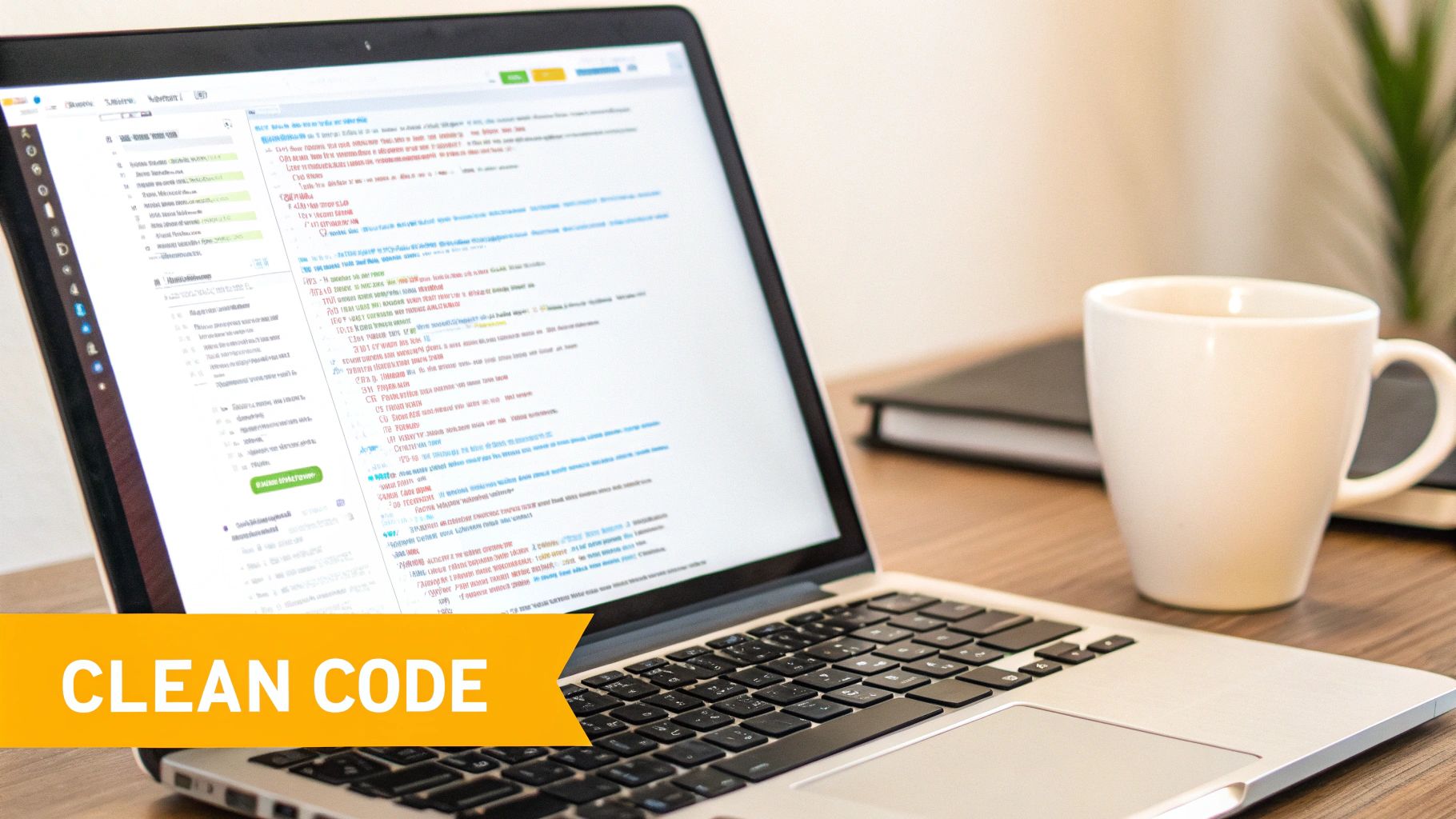Your Ultimate Code Review Checklist: 8 Pillars for 2025

Beyond 'Looks Good to Me': Transforming Your Code Review Process
In fast-paced development cycles, the code review is often reduced to a quick glance and a perfunctory approval. However, a truly effective code review is a powerful lever for enhancing software quality, preventing bugs, and fostering a culture of engineering excellence. It's the critical juncture where individual contributions are woven into a robust, maintainable, and secure codebase. Moving beyond superficial checks requires a structured approach that ensures every crucial aspect of the code is scrutinized.
This is where a definitive code review checklist becomes indispensable. It transforms an ambiguous task into a systematic quality gate, empowering every developer, from junior to senior, to contribute meaningfully. By providing a clear framework, teams can ensure consistency, catch subtle issues early, and align on best practices without endless debate. This guide provides a detailed breakdown of the essential pillars that form the foundation of a world-class code review process.
Here, we will dissect eight critical areas, offering actionable steps, practical examples, and expert insights. You will learn to methodically assess functionality, readability, security, performance, and more. Following this comprehensive code review checklist will help your team ship better, more reliable software, faster.
1. Code Functionality and Logic Review
At the heart of any effective code review checklist lies the most fundamental question: does the code actually do what it's supposed to do? This initial check, focusing on functionality and logic, is the bedrock upon which software quality is built. It’s about more than a superficial pass; it requires the reviewer to act as the first line of defense against functional bugs, ensuring the code accurately translates business requirements into tangible software behavior.

This process involves a deep dive into the code's intended purpose. As emphasized by industry leaders like Google and Microsoft in their internal engineering practices, the reviewer must validate the implementation against the original user story or ticket. The goal is to confirm that the logic is sound, the algorithms are correct, and every condition and outcome specified has been met. This meticulous validation prevents flawed features from ever reaching the testing phase, let alone end-users.
How to Implement a Functionality Review
To effectively review code functionality, you must mentally execute the proposed changes. Think through the primary success path as well as alternative flows and potential failure scenarios. For example, Netflix’s engineering culture places a strong emphasis on resilience, meaning their code reviews rigorously scrutinize edge cases and failure modes to ensure system stability.
Consider a pull request for a new user registration feature. A thorough logic review would not only check that a valid email and password create a user account. It would also verify:
- Error Handling: What happens if the email is already in use? Is a clear, user-friendly error message returned?
- Boundary Conditions: Does the password validation correctly handle minimum and maximum length requirements?
- Null Inputs: How does the system react if a required field is submitted as null or empty? Does it fail gracefully or crash?
- Data Integrity: Are mathematical calculations, like determining a trial period end date, accurate and free of off-by-one errors?
By systematically stepping through these scenarios, you ensure the code is robust and reliable, solidifying its place as a critical first step in any comprehensive code review checklist.
2. Code Readability and Maintainability
Beyond just working, code must be understandable and easy to modify. This principle of readability and maintainability is a crucial element of any professional code review checklist. It dictates that code should be written not just for the computer to execute, but for other developers to read, comprehend, and build upon. Neglecting clarity creates "technical debt," where future development becomes slow, expensive, and prone to introducing new bugs.

This focus on clean code is championed by software engineering pioneers like Robert C. Martin ("Uncle Bob"). Companies that scale successfully, like Google and Airbnb, enforce rigorous style guides to ensure consistency and clarity across vast codebases. During a review, the goal is to assess whether a new developer could quickly grasp the code's purpose and structure without extensive hand-holding. This forward-thinking approach is a cornerstone of a well-structured app development project plan, ensuring long-term project velocity.
How to Implement a Readability Review
To review for readability, you must put yourself in the shoes of a future developer. Does the code tell a clear story? Is its intent immediately obvious, or do you have to painstakingly reverse-engineer the logic? Look for code "smells" that indicate underlying complexity or poor structure.
When reviewing a contribution, check for these key indicators of clean, maintainable code:
- Descriptive Naming: Do variable and function names (e.g.,
calculateGrossRevenueinstead ofcalcRev) clearly state their purpose and intent? - Single Responsibility: Are functions kept small and focused on doing one thing well? A function named
processUserDatashould not also be sending emails. - Code Organization: Is the code logically structured within the file? Is related logic grouped together, and is there a consistent formatting style for indentation and spacing?
- Clarity Over Cleverness: Avoid overly complex one-liners or obscure language features. The goal is straightforward, self-documenting code, not a demonstration of programming acrobatics.
- Dead Code Removal: Ensure that commented-out blocks of old code, which create clutter and confusion, have been removed.
By enforcing these standards, you are not just critiquing syntax; you are investing in the future health and efficiency of the entire software project. This makes readability a non-negotiable step in a thorough code review.
3. Security Vulnerability Assessment
Beyond mere functionality, a critical responsibility of any code review is to act as a security gateway. A Security Vulnerability Assessment involves a systematic examination of code for flaws that could be exploited by malicious actors. This isn't an optional step reserved for security specialists; it's an integral part of the development lifecycle that protects the application, the business, and its users from potential harm.

This proactive approach to security is championed by organizations like the OWASP Foundation and implemented rigorously by tech leaders. For example, GitHub integrates security scanning directly into its pull request workflow, automating the detection of common vulnerabilities. Similarly, Shopify’s robust bug bounty program incentivizes developers and security researchers alike to find and report flaws, a culture that feeds back into their secure code review practices. The goal is to shift security left, addressing risks before they are ever merged into the main codebase.
How to Implement a Security Review
Integrating security into your code review checklist requires a reviewer to adopt an adversarial mindset. You must ask not just "Does this work?" but "How could this be broken or abused?" This involves scrutinizing the code for common patterns of weakness and ensuring that defensive programming principles have been applied throughout the proposed changes.
When reviewing a feature that handles user data or performs sensitive actions, a security-focused check should validate several key areas:
- Input Sanitization: Is all user-provided data properly validated and sanitized to prevent attacks like SQL injection or Cross-Site Scripting (XSS)?
- Secrets Management: Are there any hardcoded secrets, such as API keys, passwords, or tokens, committed directly into the repository? These should be managed through secure vaults or environment variables.
- Access Control: Does the code correctly enforce authentication and authorization? For instance, does an API endpoint properly verify that a user has the permission to access or modify a specific resource?
- Secure Defaults: Does the feature use secure communication protocols like HTTPS? Are session management and cookie settings configured with security in mind?
By making these checks a standard part of every review, you embed security into your team's DNA, transforming your code review checklist into a powerful tool for building resilient and trustworthy software.
4. Performance and Efficiency Optimization
Beyond mere functionality, a critical aspect of any comprehensive code review checklist is the scrutiny of performance and efficiency. Code that works but is slow, resource-intensive, or doesn't scale can be just as detrimental as code with bugs. This step involves a deliberate analysis to prevent performance bottlenecks, ensuring the software is not only correct but also fast, responsive, and cost-effective to run, especially at scale.

This focus on efficiency is a core tenet of engineering at tech giants. Amazon's code reviews for AWS services, for instance, are notoriously meticulous about resource usage, as small inefficiencies can lead to massive operational costs. Similarly, Google often incorporates "performance budgets" into their review process, setting strict limits on metrics like page load time or memory consumption. This proactive approach ensures that performance is treated as a feature, not an afterthought.
How to Implement a Performance Review
An effective performance review requires a shift in mindset from "does it work?" to "how well does it work under load?". This means looking for inefficient patterns and questioning the computational cost of the solution. For example, Netflix’s engineering teams constantly optimize their streaming algorithms during code reviews to reduce latency and buffering, directly impacting user experience and satisfaction. These performance considerations are particularly crucial in mobile contexts, where resources are more constrained. For deeper insights, you can learn more about optimizing mobile app performance on getnerdify.com.
When reviewing a pull request, be on the lookout for common performance anti-patterns:
- Algorithmic Complexity: Is there a nested loop resulting in an O(n²) algorithm where a more efficient O(n log n) or O(n) solution exists?
- Database Inefficiency: Watch for the classic "N+1 query" problem, where an application makes a database call for every item in a collection instead of fetching all the data at once.
- Memory Usage: Are large objects or files being loaded into memory unnecessarily? Could streaming or chunking be used instead?
- Caching Opportunities: Identify frequently accessed, slow-to-compute data that could be cached to improve response times.
- Network Calls: Are multiple network requests being made where a single, consolidated request would suffice?
By integrating these checks into your review process, you help build systems that are not only reliable but also scalable and delightful for users to interact with.
5. Error Handling and Exception Management
A system's true resilience is measured not by how it behaves in ideal conditions, but by how gracefully it handles failure. This makes error handling a non-negotiable part of any comprehensive code review checklist. It involves scrutinizing how the code anticipates, catches, and manages unexpected situations, ensuring the application remains robust and predictable when things go wrong. A meticulous review of exception management prevents minor issues from cascading into catastrophic system-wide failures.
This principle is deeply embedded in the design of mission-critical systems. For instance, Stripe’s API is renowned for its predictable error handling, providing developers with clear, actionable error codes that simplify integration and debugging. Similarly, the design philosophies of the Microsoft .NET Framework team and the Java community have long championed structured exception handling. The goal is to ensure that errors are not just caught but are also managed in a way that provides sufficient context for debugging, avoids exposing sensitive data, and maintains a positive user experience.
How to Implement an Error Handling Review
To effectively review error handling, you must think like a saboteur: what could possibly go wrong here? Look for try-catch blocks, error-first callbacks, and promise rejections. Analyze whether the code is simply swallowing exceptions or handling them meaningfully. The key is to ensure every potential failure point has a well-defined recovery or termination path.
Consider a feature that processes an uploaded file. A robust error handling review would verify:
- Specific Exceptions: Does the code catch a generic
Exceptionor does it distinguish between aFileNotFoundExceptionand aPermissionDeniedExceptionto provide tailored responses? - Contextual Logging: When an error is logged, does it include relevant information like the user ID, filename, and a stack trace? This context is invaluable for debugging.
- User Feedback: Is a cryptic stack trace shown to the end-user, or do they receive a friendly message like "File could not be processed. Please check the file format and try again"?
- Resource Management: Does the code ensure that resources, like file streams, are properly closed in a
finallyblock or using ausingstatement, even when an exception occurs?
By systematically challenging the code's resilience, you ensure the application can withstand real-world chaos, making it a critical checkpoint in your code review process.
6. Testing Coverage and Quality Validation
Code without tests is simply unverified code. A critical component of any comprehensive code review checklist is validating not just the production code, but also the tests that accompany it. This step ensures that new logic is adequately covered by automated tests and, just as importantly, that existing functionality remains intact. It’s about building a safety net that catches regressions before they can impact users.
This principle is a cornerstone of modern software engineering, championed by thought leaders like Kent Beck through Test-Driven Development and practiced rigorously at tech giants. For instance, Google's engineering standards often mandate that tests are submitted with every significant code change. This practice ensures that testability is a core design consideration, not an afterthought. The reviewer's job is to scrutinize these tests for quality, confirming they aren't just for show but provide real validation.
How to Implement a Testing Quality Review
A proper test review goes beyond just checking for the presence of a test file. It requires you to assess the quality and intent of the tests themselves. Think of yourself as an adversary trying to break the code; would these tests catch your attempts? Facebook’s engineering teams, for example, rely on extensive automated testing tied into their review process to maintain stability across a massive, rapidly changing codebase.
When reviewing the tests associated with a pull request, focus on these key validation points:
- Assertiveness and Intent: Does the test actually verify the core logic of the feature? A meaningful test should fail if the corresponding production code is broken. Check that assertions are specific and not just testing for trivial outcomes.
- Positive and Negative Paths: The tests must cover both the "happy path" (expected inputs and outcomes) and negative scenarios. This includes testing how the code handles invalid data, unexpected nulls, and error conditions.
- Clarity and Maintainability: Are the test names descriptive? A test named
test_user_creationis vague, whereastest_fails_when_creating_user_with_duplicate_emailclearly communicates its purpose, making future maintenance easier. - Independence and Repeatability: Each test should be self-contained and not depend on the state left by a previous test. This ensures that the test suite is reliable and produces consistent results every time it runs.
By embedding this rigorous test validation into your code review checklist, you build confidence in every change and foster a culture where quality is a shared responsibility.
7. Code Standards and Style Consistency
While functionality is paramount, the long-term health and maintainability of a codebase depend heavily on consistency. This step in the code review checklist ensures that new contributions adhere to established coding standards and style guides. It's about more than just aesthetics; consistent code is predictable, easier to read, and simpler for new team members to understand. This reduces cognitive load, allowing developers to focus on solving business problems rather than deciphering idiosyncratic code.
Enforcing standards prevents the codebase from becoming a tangled mix of personal preferences, which can slow down future development and make bug-fixing a nightmare. Prominent organizations like Google and Airbnb have invested heavily in creating and popularizing comprehensive style guides for this very reason. For example, Airbnb's JavaScript Style Guide is one of the most widely adopted standards in the industry, proving that a unified style is a cornerstone of scalable, collaborative software engineering.
How to Implement a Standards and Style Review
The most effective way to manage style consistency is to automate as much as possible. Debating brace placement or spacing during a manual review is an inefficient use of a developer's time. Instead, leverage automated tools to enforce the rules, freeing up the human reviewer to concentrate on more complex issues like logic and architecture. This approach is central to the development philosophies at companies like Facebook, which rely on tools like Prettier to auto-format code on commit.
To build a robust standards check into your process, consider the following actions:
- Automate Formatting: Integrate tools like Prettier (for code formatting) and ESLint (for identifying problematic patterns) into your development workflow. Configure them to run automatically before a commit or as part of your continuous integration pipeline.
- Document Conventions: For rules that cannot be automated, such as naming conventions for components or architectural patterns, maintain a clear and accessible internal document. This guide becomes the single source of truth for the team.
- Focus on Consistency: The primary goal is uniformity with the existing codebase. Even if a reviewer has a different personal preference, the established team standard should always take precedence to maintain coherence.
- Regularly Update Guidelines: A style guide is a living document. Periodically review and update it with the team to ensure it evolves with new technologies and best practices, keeping it relevant and effective.
8. Architecture and Design Pattern Compliance
Beyond individual lines of code, a comprehensive code review must zoom out to assess how new changes fit within the larger system. This is where architecture and design pattern compliance comes in, ensuring that new code adheres to the established structural blueprints of the application. It’s about maintaining long-term health, scalability, and consistency, preventing the gradual decay of a well-designed system into a complex, unmanageable monolith.
Evaluating architectural compliance means verifying that the code respects foundational principles like separation of concerns and the single responsibility principle. As Robert C. Martin emphasizes in "Clean Architecture," these principles are not academic; they are pragmatic tools for building resilient and maintainable software. Neglecting this step in a code review checklist can lead to tightly coupled components and "technical debt" that slows future development to a crawl.
How to Implement an Architectural Review
To properly assess architectural compliance, you must understand the system's intended design. This often involves referring to architectural decision records (ADRs) or design documents. For example, at companies like Uber and Netflix, where microservices are prevalent, reviews critically ensure that new services don’t introduce circular dependencies or violate communication protocols, preserving the integrity of the overall architecture.
When reviewing a pull request, focus on the structural impact of the changes. Here’s what to look for:
- Separation of Concerns: Does the code mix business logic with presentation or data access concerns? For instance, UI components should not contain database queries.
- Dependency Direction: Are dependencies pointing in the right direction? In a layered architecture, higher-level modules should not depend on lower-level modules; both should depend on abstractions.
- Pattern Adherence: If your team uses specific design patterns like the Repository or Factory pattern, verify the new code implements them correctly.
- Interface Contracts: Are interfaces well-defined and respected? The changes should not break existing contracts that other parts of the system rely on.
This architectural lens is a crucial part of any effective code review checklist, safeguarding the system’s structural foundation. To delve deeper into how these principles are applied in practice, you can learn more about custom web application development and its architectural underpinnings.
Code Review Checklist Comparison
| Item | Implementation Complexity 🔄 | Resource Requirements 🔄 | Expected Outcomes 📊 | Ideal Use Cases 💡 | Key Advantages ⭐ |
|---|---|---|---|---|---|
| Code Functionality and Logic Review | Medium to High - requires domain and requirements understanding | Moderate - needs requirement docs and expertise | High correctness, business rule validation | Critical business logic verification, edge cases | Catches functional bugs early, reduces failures |
| Code Readability and Maintainability | Medium - involves style and organization judgment | Low to Moderate - needs time and style guides | Clean, maintainable code, easier debugging | Long-term maintenance, team collaborations | Improves productivity, facilitates knowledge transfer |
| Security Vulnerability Assessment | High - requires security expertise | High - specialized skillset and extended review | Secure code, compliance, breach prevention | Apps handling sensitive data, regulatory needs | Protects data, prevents attacks, maintains reputation |
| Performance and Efficiency Optimization | High - requires performance profiling and analysis | Moderate to High - needs testing tools and expertise | Faster response, reduced costs, scalability | Performance-critical systems, high-load apps | Improves speed, reduces infrastructure costs |
| Error Handling and Exception Management | Medium - careful balance needed | Low to Moderate - requires thorough review | Robust app behavior, better debugging | Applications needing reliability and graceful failure | Enhances reliability and monitoring |
| Testing Coverage and Quality Validation | Medium to High - needs test design and validation | Moderate to High - requires test writing and maintenance | Fewer bugs, confident refactoring, documented behavior | Continuous integration, complex code changes | Reduces bugs, supports CI, documents expected results |
| Code Standards and Style Consistency | Low to Medium - mostly rule enforcement | Low - tooling and team agreement required | Consistent codebase, easier collaboration | Teams needing uniform coding practices | Improves collaboration, reduces cognitive load |
| Architecture and Design Pattern Compliance | High - needs deep architectural knowledge | Moderate - requires experienced reviewers | Coherent system architecture, scalable design | Large-scale systems, long-term projects | Enables scalability, system coherence, reusability |
Building a Culture of Quality, One Review at a Time
Adopting a comprehensive code review checklist is far more than a procedural step; it represents a fundamental cultural shift toward engineering excellence. Throughout this guide, we've explored the eight critical pillars of an effective code review: functionality, readability, security, performance, error handling, testing, standards, and architecture. Moving beyond a simple "does it work?" mentality to embrace this holistic approach is what separates good teams from great ones. It transforms the code review from a gatekeeping chore into a powerful mechanism for mentorship, collaboration, and collective ownership.
When these principles are consistently applied, the benefits extend well beyond catching a few bugs. You are actively building a shared understanding of your codebase, which makes future development faster and more predictable. Junior developers learn best practices directly from senior engineers' feedback, while senior engineers gain fresh perspectives and are challenged to articulate their reasoning. This cycle of continuous improvement is the engine that drives the creation of robust, scalable, and secure applications.
Your Actionable Path Forward
Integrating this detailed code review checklist into your workflow might seem daunting, but you can start small and build momentum. Here are your next steps:
- Customize and Adopt: Don't just copy and paste this list. Meet with your team to discuss each section. Which points are most critical for your current projects? What existing pain points can be addressed immediately? Create a version of this checklist that is tailored to your team's specific needs, technologies, and goals.
- Establish a Baseline: Begin by focusing on one or two key areas. Perhaps you start with Code Readability and Maintainability and Security Vulnerability Assessment. Mastering these areas first will deliver immediate, tangible value and build confidence in the process.
- Automate What You Can: Use static analysis tools, linters, and formatters to automate checks for code standards and style consistency. This frees up human reviewers to focus on the more complex aspects that tools can't catch, like architectural integrity and business logic. Let the machines handle the syntax so your team can focus on the substance.
- Measure and Iterate: Track metrics related to your review process. How long do reviews take? How many critical issues are caught before they reach production? Use this data to refine your code review checklist and processes over time, ensuring it remains a valuable and efficient part of your development lifecycle.
Ultimately, a world-class code review process is the bedrock of a high-performing engineering culture. It’s an investment in your team’s skills, the quality of your product, and the long-term health of your codebase. By embracing these principles, you are not just checking boxes; you are building a legacy of quality, one pull request at a time.